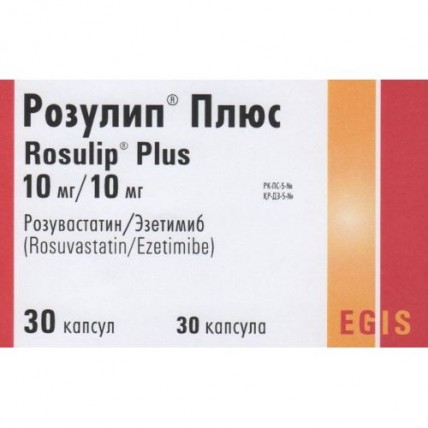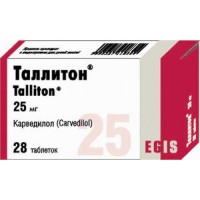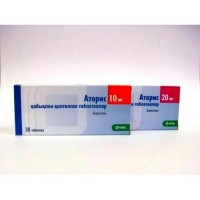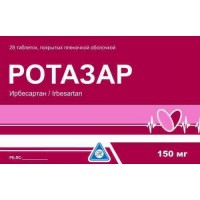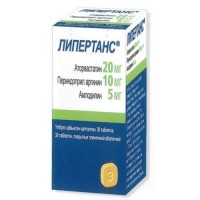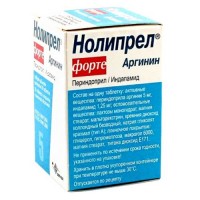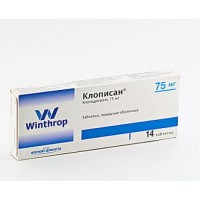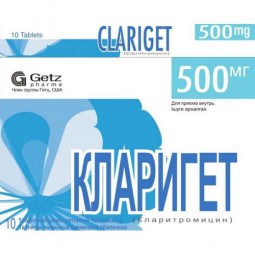Rosulip® Plus (Rosuvastatin / Ezetimibe) 10 mg/10 mg, 30 Capsules
- $56.80
Sku:
55c797f1d12d
Brand:
Egis (Hungary)
The instruction for medical use of medicine of ROZULIP® PLUS Torgovoye nazvaniye Rozulip® Plus the International unlicensed name Is not present the Dosage form of the Capsule of 10 mg / 10 mg, 20 mg / 10 mg Structure One capsule of 10 mg / 10 mg contains active agents: rosuvastatin of 10 mg (10.68 mg of rosuvastatin of zinc are equivalent) an ezetimiba of 10 mg, One capsule of 20 mg / 10 mg contains active agents: rosuvastatin of 20 mg (21.36 mg of rosuvastatin of zinc are equivalent) an ezetimiba of 10 mg, excipients: cellulose silicon microcrystalline (cellulose microcrystalline, silicon dioxide colloidal anhydrous), silicon dioxide colloidal anhydrous, magnesium stearate, povidone, sodium of a kroskarmelloz, Mannitolum, sodium lauryl sulfate, hydroxypropyl cellulose with low extent of substitution, Structure of a solid gelatin capsule (CONI–SNAP 0): ferrous oxide yellow (E172), the titan dioxide (E171), gelatin (for a dosage of 10 mg / 10 mg) ferrous oxide red (E172), ferrous oxide yellow (E172), the titan dioxide (E171), gelatin (for dosages of 20 mg / 10 mg) the Description of the Capsule of 10 mg / 10 mg (rosuvastatin / ezetimib): the solid gelatin capsules of CONI-SNAP 0 which, not marked, are self-closed, with the body of yellow color and a cover of yellow color, the containing two tablets Contents of Capsules: Tablets of rosuvastatin of 10 mg: white or almost white, oblong tablets, with an engraving of the stylized letter E and number 596 on one party of a tablet, without or almost flavourless. Tablets of an ezetimib: white or almost white, round flat tablets with a facet, with an engraving of the stylized letter E on one party of a tablet and number 612 on other party of a tablet, without or almost flavourless (for a dosage of 10 mg / 10 mg). Capsules of 20 mg / 10 mg (rosuvastatin / ezetimib): the solid gelatin capsules of CONI-SNAP 0 which, not marked, are self-closed, with the body of yellow color and a cover of color of caramel, the containing two tablets. Contents of capsules: Tablets of rosuvastatin of 20 mg: white or almost white, oblong tablets, with an engraving of the stylized letter E and number 597 on one party of a tablet, without or almost flavourless. Tablets of an ezetimib: white or almost white, round flat tablets with a facet, with an engraving of the stylized letter E on one party of a tablet and number 612 on other party of a tablet, without or almost flavourless (for a dosage of 20 mg / 10 mg) Pharmacotherapeutic group Hypolipidemic drugs. Reductase HMG-CoA inhibitors in a combination with other hypolipidemic means. Rosuvastatin and ezetimib. The ATX C10BA06 code the Pharmacological Pharmacokinetics Rosuvastatin Maximum Concentration properties of rosuvastatin in blood plasma is reached approximately in 5 h after oral administration. The absolute bioavailability is about 20%. Rosuvastatin is absorbed, mainly by a liver where there is the main synthesis of cholesterol and removal of Hs-LPNP. The volume of distribution of rosuvastatin is about 134 l. About 90% of rosuvastatin contact proteins of plasma, mainly albumine. Rosuvastatin in insignificant degree is exposed to metabolism (okolo10%). Rosuvastatin is non-core substrate for isoenzymes of a system of P450 cytochrome. The main enzyme participating in rosuvastatin metabolism is CYP2C9. CYP2C19, CYP3A4 and CYP2D6 enzymes are involved in metabolism to a lesser extent. The main derivatives of rosuvastatin are N-desmetil a metabolite and lactonic metabolites. N-desmetil for about 50% is less active, than rosuvastatin, lactonic derivatives pharmacological are inactive. Rosuvastatin provides suppression of activity of more than 90% of the circulating HMG-CoA-reductase. About 90% of a dose of rosuvastatin are removed in not changed view with excrements (including the absorbed and not absorbed rosuvastatin). The rest of a dose is removed with urine. About 5% of a dose of drug are excreted with urine in not changed state. Elimination half-life of drug makes about 19 hours of blood plasma. Elimination half-life does not change at increase in a dose of drug. The average geometrical plasma clearance is about 50 liters/hour (coefficient of variation of 21.7%). Similar to other HMG-CoA-reductases inhibitors, in the course of hepatic capture of rosuvastatin the membrane protein carrier of organic anions like C (OATP-C) which is carrying out an important role in hepatic elimination of rosuvastatin participates. The system bioavailability of rosuvastatin increases in proportion to a dose. When using drug several times in day the pharmacokinetic parameters do not change. Special groups of patients Age and sex: Clinically significant influence of age and sex on pharmacokinetic properties of rosuvastatin was not noted. The rosuvastatin pharmacokinetics at use for children and teenagers with a family heterozygous hypercholesterolemia was similar to pharmacokinetics of adult patients. Race: Results of pharmacokinetic researches demonstrate that in comparison with persons of Caucasian race, at persons of Asian race (Japanese, Chinese, Filipinos, Vietnamese and Koreans) average area under a curve concentration time (area under the curve, AUC) and the maximum concentration of drug in blood plasma (Cmax) is approximately twice higher. At Indians these indicators are approximately 1.3 times higher, than at persons of Caucasian race. The analysis of population pharmacokinetics did not reveal clinically significant differences in pharmacokinetic parameters of rosuvastatin between persons of Caucasian and negroid race. Patients with a renal failure. The slight or moderate renal failure did not influence concentration of rosuvastatin or a N-desmetil-metabolite in blood plasma. Patients with a heavy renal failure (clearance of creatinine & lt, 30 ml/min.) had a concentration of rosuvastatin and a N-desmetil-metabolite, respectively, in 3 and 9 times is higher, than at healthy patients. At the patients receiving hemodialysis sessions, plasma concentration of rosuvastatin in an equilibrium state was 50% higher, than at healthy patients. Patients with a liver failure: Patients with a liver failure of varying severity had no data on increase in influence of rosuvastatin at persons with value less than 7 points on a scale of Chaylda-Pyyu. However at 2 participants with values 8 and 9 of points on a scale of Chaylda-Pyyu observed increase in system influence of rosuvastatin, at least, twice in comparison with participants with lower values on a scale of Chaylda-Pyyu. There is no experience of use of rosuvastatin for persons with value more than 9 points on a scale of Chaylda-Pyyu. Genetic polymorphism. Transport proteins of OATP1B1 and BCRP participate in removal of ngibitor of GMG-KoA-reduktazy including rosuvastatin. Patients with genetic polymorphism of SLCO1B1 (OATP1B1) and/or ABCG2 (BCRP) have a risk of increase in exposure of rosuvastatin. For individual polymorphism of SLCO1B1 with. 521CC and ABCG2 with. 421AA increase in exposure (AUC) in rosuvastatin respectively by 1.7 times and 2.4 times, in comparison with SLCO1B1 genotypes is characteristic with. 521TT and ABCG2 with. 421CC. Patients of children's age. Rosuvastatin pharmacokinetics parameters at patients of children's age of 10-17 years with a heterozygous hereditary hypercholesterolemia are characterized not completely. The small research of pharmacokinetics of rosuvastatin at 18 children showed that influence of rosuvastatin at patients of children's age, apparently, is similar to that at adults. Besides, results of a research show that considerable deviations from a dozozavisimost are not expected. Ezetimib After oral administration ezetimib it is quickly soaked up and substantially conjugated with formation pharmacological of an active phenolic glucuronide - an ezetimib a glucuronide. Average values of the maximum concentration of an ezetimib in plasma (Cmax) are observed in 1–2 h and 4–12 h after reception – respectively, for an ezetimib of a glucuronide and an ezetimib. The absolute bioavailability of an ezetimib cannot be defined as it is almost not soluble in the water environments suitable for injections. The concomitant use of food (with the high and low content of fats) does not affect bioavailability of an ezetimib after oral administration. Ezetimib it is possible to accept irrespective of meal. Linking of an ezetimib and its glucuronide with proteins of plasma makes, respectively, 99.7% and 88–92%. Metabolism of an ezetimib happens mainly in a small intestine and in a liver, by means of a glyukuronirovaniye (reaction of phase II) and the subsequent removal to bile. At all studied types noted minimum significant oxidizing metabolism of an ezetimib (reaction of phase I). Ezetimib and the ezetimib-glucuronide, the main derivatives of drug, make 10-20% and 80-90% of the general content of drug in blood plasma respectively. Ezetimib and an ezetimib-glucuronide are slowly brought out of blood plasma in the course of enterohepatic recirculation. Time of half-decay of an ezetimib and ezetimib-glucuronide is about 22 h. Special groups of patients Age and sex of patients: At patients 65 years concentration of the general ezetimib in blood plasma approximately twice above, than at patients at the age of 18-45 years are more senior. Level of decrease Hs-LPNP and profiles of safety at the elderly and younger patients accepting ezetimib are approximately identical. Therefore dose adjustment for patients of advanced age is not required. The general concentration of an ezetimib is about 20% higher at women, than at men. Level of decrease Hs-LPNP and profiles of safety are approximately identical at the men and women accepting ezetimib. Therefore, the sex is not a reason for dose adjustment. Patients with a renal failure: After single dose in an ezetimib of 10 mg at patients with a heavy renal failure (KK of ≤30 ml/min.), the average AUC value increased by 1.5 times in comparison with healthy participants. This result is not considered clinically significant. For patients with the weakened renal function the dose adjustment is not required. In this research at one patient (who transferred transplantation of a kidney, receiving various medicines, including cyclosporine) the general influence of all forms of an ezetimib was increased by 12 times. Patients with a liver failure: After single dose of 10 mg of an ezetimib the average AUC value for all forms of an ezetimib was about 1.7 times higher than at patients with a liver failure of small expressiveness (5–6 points on a scale of Chaylda-Pyyu) in comparison with healthy participants. In a 14-day research with daily reception of an ezetimib in a dose of 10 mg/days at patients with a liver failure of moderate degree (7–9 points on a scale of Chaylda-Pyyu) average AUC for all forms of an ezetimib was about 4 times higher in comparison with healthy participants (for the 1st and 14th day of a research). With small insufficiency of function of a liver the dose adjustment is not required from patients. In view of unknown effects of the increased influence of an ezetimib at patients with a liver failure of moderate or considerable weight (& gt, 9 points on a scale of Chaylda-Pyyu) use of an ezetimib for such patients is not recommended. Patients of children's age. Absorption and metabolism of an ezetimib are similar at children, teenagers (10–18 years) and at adults. On the basis of data for the general maintenance of an ezetimib it is possible to draw a conclusion on lack of differences in pharmacokinetics between adults and teenagers. Data of pharmacokinetics for children are younger than 10 years are absent. Clinical experience of use of drug for children and teenagers includes patients with gomo- or a heterozygous family hypercholesterolemia or a sitosterolemiya. Combination therapy by rosuvastatin and ezetimiby Combined use of 10 mg of rosuvastatin and 10 mg of an ezetimib led to increase in AUC rosuvastatin by 1.2 times (at patients with a hypercholesterolemia). It is impossible to exclude pharmakodinamichesky interaction between rosuvastatin and ezetimiby concerning adverse effects. Pharmacodynamics Rosuvastatin Rosuvastatin – a selection, competitive inhibitor of HMG-CoA-reductase – the enzyme catalyzing transformation of 3-hydroxy-3-methylglutaryl-coenzyme A in mevalonat, the predecessor of cholesterol. The main target of effect of rosuvastatin is the liver where synthesis of cholesterol (XC) and catabolism of lipoproteins of the low density (LDL) is carried out. Rosuvastatin increases the number of hepatic receptors of LDL by surfaces of cells at the expense of what capture and catabolism of LDL amplifies and synthesis of lipoproteids of very low density (LPONP) in a liver is suppressed. As a result the total number of LPONP and LDL decreases. Rosuvastatin reduces the increased content of LDL cholesterol (Hs-LPNP), the general cholesterol and triglycerides (TG), increases the level of cholesterol of lipoproteids of the high density (Hs-LPVP) and also reduces apolipoprotein B content (ApoV), cholesterol NELPVP (Hs-neLPVP), LPONP cholesterol (Hs-LPONP), LPONP (TG-LPONP) triglycerides and increases the content of A-I apolipoprotein (ApoA-I), reduces a ratio of Hs-LPNP/Hs-LPVP, the general cholesterol / Hs-LPVP, Hs-neLPVP/Hs-LPVP and ApoV/ApoA-I. (see Table 1). Table 1. Effects of various doses of drug at treatment of patients with primary hypercholesterolemia (IIa and IIb type) (the corrected average percentage changes in comparison with initial level) the Dose of N Hs-LPNP Obshchy ApoV ApoA Hs-LPVP Triglitseridy Hs-neLPVP cholesterol I of Placebo of 13 - 7 - 5 3 - 3 - 7 - 3 0 5 mg 17 - 45 - 33 13 - 35 - 44 - 38 4 10 mg 17 - 52 - 36 14 - 10 - 48 - 42 4 20 mg 17 - 55 - 40 8 - 23 - 51 - 46 5 40 mg 18 - 63 - 46 10 - 28 - 60 - 54 0 The therapeutic effect is shown within one week after the beginning of therapy by drug, in 2 weeks of treatment reaches 90% of the greatest possible effect. The maximum therapeutic effect is usually reached by 4th week and maintained at regular reception. Ezetimib Ezetimib – is the representative of a new class of hypolipidemic connections who selectively suppresses absorption of cholesterol and the related phytosterols in intestines. The mechanism of action differs from other groups of hypolipidemic means (for example, statines, sekvestrant of bile acids, fibrat and fitostanol). A molecular target of an ezetimib is the protein similar to protein of Nimanna-Pika of C1 type (NPC1L1-Niemann-Pick C1-Like 1) who participates in intracellular transport of cholesterol. Ezetimib is located in a brush border of an epithelium of a small intestine and suppresses cholesterol absorption there that reduces intake of cholesterol from intestines in a liver. Statines reduce synthesis of cholesterol in a liver. At the expense of 2 various mechanisms ezetimib and statines provide additional decrease in level of cholesterol. At patients with a hypercholesterolemia ezetimib suppresses absorption of cholesterol in intestines 54% more, in comparison with placebo. Ezetimib suppresses absorption
- cholesterol without impact on absorption of triglycerides, fatty acids, bile acids, progesterone, ethinylestradiol, or A and D oil-soluble vitamins. Epidemiological researches show that cardiovascular incidence and mortality directly correlate with levels of the general XC and HS-LPVP and back correlate with the HS-LPVP level. The beneficial effect of an ezetimib on cardiovascular incidence and mortality is not established yet. Simultaneous use of rosuvastatin and an ezetimib Clinical performance Data of researches show that addition of an ezetimib to therapy of 5 or 10 mg of rosuvastatin reduced LDL cholesterol level by 21%. Contrary to it, increase in a dose of rosuvastatin from 10 to 20 mg led to decrease in LDL cholesterol by 5.7% (the difference between groups is equal to 15.2%, p & lt, 0.001). In the individual analysis it was shown that ezetimib + rosuvastatin of 5 mg more considerably reduced LDL cholesterol level in comparison with reception of 10 mg of rosuvastatin (distinction by 12.3%, p & lt, 0.001), and ezetimib + rosuvastatin of 10 mg more considerably reduced LDL cholesterol level in comparison with reception of 20 mg of rosuvastatin (distinction by 17.5%, p & lt, 0.001). In open randomized 12 weeks study estimated the level of decrease in LDL in each of groups of treatment (rosuvastatin of 10 mg + ezetimib 10 mg, rosuvastatin of 20 mg + ezetimib 10 mg, simvastatin 40 mg + ezetimib 10 mg, simvastatin 80 mg + ezetimib 10 mg). Decrease in cholesterol of rather initial level was 59.7% at use of a combination with a low dose ro
a uvastatina that is a little higher, than at use of a combination with a low dose of a simvastatin: 55.2% (p<, 0.05). Use of a combination with a high dose of rosuvastatin reduced cholesterol level by 63.5%: in comparison with decrease by 57.4% at use of a combination with a high dose of a simvastatin (p<, 0.001). Indications Treatment of primary hypercholesterolemia at adults (as addition to a diet): - at insufficient control of a disease at monotherapy of rosuvastatin, or - as replacement therapy at patients with sufficient control of a disease at a concomitant use of both separate substances in the same doses, as the fixed combination. The route of administration and doses use Drug strictly on doctor's orders! Rozulip Plus should be accepted inside at the same time day, irrespective of meal. The capsule should be swallowed entirely and to wash down with water. Prior to the beginning of and during all course of therapy of Rozulip Plus the patient has to keep to a standard diet with the low content of cholesterol. The dose of drug should be selected individually on the basis of target levels of lipids, depending on the purposes of therapy and the response to treatment. The combined treatment should be begun only after definition of the required dosage of rosuvastatin or both components of drug. The dosage also has to consider risk of adverse reactions. Dose adjustment can be carried out after 4 weeks of therapy. The recommended daily dose makes one capsule accepted irrespective of food. Rozulip Plus does not approach as the first line of hypolipidemic therapy. Capsules of Rozulip Plus of 10 mg / 10 mg and 20 mg / 10 are not suitable mg for treatment of patients which needs a dose of rosuvastatin, equal 40 mg. Rozulip Plus should take for ≥2 h to or in ≥4 h after reception of the sekvestrant of bile acids. Patients of children's age Safety and efficiency of Rozulip Plus at persons are younger than 18 years are not established. Patients of advanced age At patients are more senior than 70 years the recommended initial dose of rosuvastatin of 5 mg. This combination of drugs does not approach as therapy of the first line. Combination therapy should be begun only after selection of a suitable dose of rosuvastatin or both components. Patients with a renal failure with a slight or moderate renal failure the dose adjustment is not required From patients. At patients with moderate disturbance of renal function (clearance of creatinine & lt, 60 ml/min.) intake of rosuvastatin is recommended to begin 5 mg with a dose. The fixed combination of doses does not approach as therapy of the first line. The combined treatment should be begun only after selection of a suitable dose of rosuvastatin or both components. Use of any doses of rosuvastatin for patients with heavy disturbance of renal function is contraindicated. Patients with a liver failure with a slight abnormal liver function (5–6 points on a scale of Chaylda-Pyyu) dose adjustment is not required From patients. Use of Rozulip Plus is not recommended at patients with moderated (7–9 points on a scale of Chaylda-Pyyu) or a heavy abnormal liver function (& gt, 9 points on a scale of Chaylda-Pyyu). Rozulip Plus is contraindicated to patients with acute diseases of a liver. Race At patients the Asian of race noted the increased system influence of rosuvastatin. Patients of Asian origin have a recommended initial dose of rosuvastatin - 5 mg. The fixed combination of doses does not approach as therapy of the first line. The combined treatment should be begun only after selection of a suitable dose of rosuvastatin or both components. Genetic polymorphism Some types of gene polymorphism increase system influence of rosuvastatin. At patients with the established existence of some types of polymorphism the use of lower daily dose of Rozulip Plus is recommended. The patients predisposed to a myopathy the Recommended initial dose of rosuvastatin at the patients predisposed to a myopathy - 5 mg. The fixed combination of doses does not approach as therapy of the first line. The combined treatment should be begun only after selection of a suitable dose of rosuvastatin or both components. Simultaneous therapy by other drugs Rosuvastatin is substrate of various proteins conveyors (OATP1B1 and BCRP). The risk development of a myopathy (including rhabdomyolysis) increases at simultaneous use of Rozulip Plus with some drugs capable to increase concentration of rosuvastatin in plasma as a result of interaction with above-mentioned transport proteins (for example, cyclosporine and also some inhibitors of proteases, including a combination of a ritonavir with atazanoviry, lopinaviry and/or tipranaviry). Whenever possible, it is necessary to take the alternative drugs, and if necessary – to consider the possibility of temporary cancellation of Rozulip Plus. In cases when combined use of such medicines and Rozulip Plus is inevitable, it is necessary to consider carefully the advantage and risk connected with the combined treatment and change of a dose of rosuvastatin. Side effects the Adverse reactions noted at intake of rosuvastatin usually are passing and have small weight. Often (1/100 – 1/10) - sugar diabet1 - head bol4, dizziness - nausea, pain in zhivote2, meteorizm2, a constipation, diareya2 - mialgiya4 - an asthenia, utomlyaemost2 - increase in the ALT and/or AST4 level Infrequently (1/1.000 – 1/100) - decrease appetita3 - paresteziya4 - prilivy2 - arterial gipertenziya2 - cough - dryness in rtu4, toshnota2, dispepsiya2, gastroesophageal reflux bolezn2, gastrit4 - skin zud4, skin syp4, krapivnitsa4 - artralgiya2, muscular spazmy2, pain in shee2, pain in spine4, muscular slabost4, pain in konechnostyakh4 - pain in chest kletke2, bol2, asteniya4, peripheral oteki4 - increase in the ALT and/or AST2 levels, increase in KFK krovi2, increase γ-глутамилтрансферазы2, deviations of biochemical indicators of function pecheni2 is rare (1/10.000 – 1/1.000) - thrombocytopenia - hypersensitivity reactions, including a Quincke's edema - pancreatitis, increase in hepatic transaminases - a myopathy and a miositis, a rhabdomyolysis Very seldom (1/10.000) - polyneuropathy, memory loss - jaundice, hepatitis - an arthralgia - a hamaturia - a gynecomastia It is unknown (it is impossible to estimate on the basis of the available data). - trombotsitopeniya5 - hypersensitivity (including skin rash, a small tortoiseshell, an anaphylaxis, a Quincke's edema) 5 - depressiya5 - peripheral neuropathy, sleep disorders (including insomnia and nightmares) - golovokruzheniye5, paresteziya5 - cough, odyshka5 - diarrhea, pankreatit5, zapor5 - gepatit5, holelitiaz5, holetsistit5 - Stephens-Johnsona2 syndrome - mnogoformny eritema5 - the immuno-mediated necrotizing myopathy, damages of sinews, sometimes with their gap - artralgiya5, mialgiya5, a myopathy, rabdomioliz5 - hypostasis - asteniya5 1pri intake of rosuvastatin the frequency of cases of diabetes depends on existence or lack of risk factors (glucose level on an empty stomach ≥ 5.6 mmol/l, the body mass index & gt, 30 kg/sq.m, increase in level of triglycerides, arterial hypertension in the anamnesis). 2 Monoterapiya ezetimiby. The adverse reactions noted at the patients accepting ezetimib (N=2396) and with a bigger frequency than at intake of placebo (N=1159) 4 Ezetimib at joint reception with statine. The adverse reactions noted at the patients accepting ezetimib and statine (N=11308) and with a bigger frequency than at intake of only one statine (N=9361). 5 Additional adverse reactions noted at post-registration use of an ezetimib. As these adverse phenomena are revealed on the basis of spontaneous messages, the frequency of these phenomena is not known and cannot be calculated. As well as at use of other inhibitors of GMG-KoA-reduktazy, the frequency of adverse medicinal reactions has dose-dependent character. At the patients accepting rosuvastatin the proteinuria, in most cases canalicular on a proiskhozhdeniiya, determined by express method was observed. Changes in protein of urine from its total absence or a small amount to ++ or it was more observed at 1% of patients during treatment by a dosage of 10 mg or 20 mg. Small increase from total absence or a small amount to + was observed at reception of a dose of 20 mg. In most cases at continuous treatment the proteinuria decreased or disappeared. On the basis of information obtained during clinical trials, and post-registration experience the lack of interrelation between a proteinuria and the acute or progressing renal failure is established. The hamaturia was in rare instances found in some patients accepting rosuvastatin. Undesirable effects from skeletal muscles, for example, myalgia, a myopathy (including a miositis) and, in rare instances, a rhabdomyolysis, with development of an acute renal failure or without that were observed at patients who received rosuvastatin in any doses, and is especially frequent, in the doses exceeding 20 mg. At some patients taking the drug the dose-dependent increase in concentration of KFK was revealed. In most cases, this phenomenon had easy, asymptomatic and passing temper. At the increased concentration of KFK in blood serum (more than by 5 times in comparison with VGN) therapy by rosuvastatin should be stopped. As well as in case of intake of other HMG-CoA-reductases inhibitors, at a small amount of the patients accepting rosuvastatin the dose-dependent increase in content of transaminases in blood serum which in most cases, had easy, asymptomatic and passing temper was observed. Against the background of therapy some statines registered the following by-effects: disturbances of sexual function, very exceptional cases of an interstitial disease of lungs registered generally at long-term therapy by statines. Frequency of development of a rhabdomyolysis, the profound renal failures and serious violations from a liver (which are generally given by increase in concentration of transaminases) above when using drug in a dose of 40 mg. In controlled clinical trials of monotherapy the frequency of clinically significant increase in transaminases of serum (ALT and/or nuclear heating plant ≥ 3 VGN) was similar in groups of an ezetimib (0.5%) and placebo (0.3%). In researches of a combination of drugs the frequency of increase was 1.3% at the patients accepting ezetimib + statine, and the patients accepting only statine have 0.4%. These episodes of increase usually were asymptomatic, were not associated with a cholestasia, and values of transaminases were restored to initial level after the termination of treatment or against the background of the continuing treatment. In clinical trials the increase in KFK & gt, 10 VGN was noted at 4 of 1674 (0.2%) the patients accepting only ezetimib at 1 of 786 (0.1%) the patients accepting placebo at 1 of 917 patients (0.1%) accepting ezetimib + statine and at 4 of 929 patients (0.4%) accepting only statine. In comparison with the corresponding control group (placebo or monotherapy by statine) reception of an ezetimib was not associated with increase in frequency of a myopathy or a rhabdomyolysis. Rosuvastatin. Increase in level of a kreatinfosfokinaza in 10 times more of the upper bound of norm and also the muscular symptoms following exercises or the increased physical activity were observed more often during 52-week clinical trial of children and teenagers, in comparison with adults. On other indicators the results of a research of safety of rosuvastatin at children, teenagers and adults match. Ezetimib. In a research with participation of teenagers (10–17 years) with a heterozygous family hypercholesterolemia (n = noted the 248th episodes of increase in ALT and/or nuclear heating plant (≥3 VGN) at 3% of patients (4 persons) accepting ezetimib and simvastatin in comparison with 2% (2 persons) in group of monotherapy simvastatiny. As for increase in KFK ≥ 10 VGN, these values were, according to 2% (2 persons) and 0%. Cases of a myopathy were not noted. This research was not suitable for comparison of rare adverse medicinal reactions. Contraindications hypersensitivity to active agents (rosuvastatin, ezetimib) or to liver disease excipients in an active phase, including permanent increase in concentration of transaminases in blood serum and any increase in activity of transaminases in blood serum (more than by 3 times in comparison with the upper bound of norm) pregnancy and the period of a lactation - at women of reproductive age who do not use effective methods of contraception the profound renal failures (clearance of 30 creatinine of ml/min.) of a myopathy a concomitant use of cyclosporine Medicinal interactions Cyclosporine. At simultaneous use with rosuvastatin, indicators of AUC rosuvastatin were about 7 times higher, than at monotherapy by drug at healthy faces. Simultaneous use of rosuvastatin and cyclosporine does not affect plasma concentration of cyclosporine. Simultaneous use of Rozulip Plus and cyclosporine contraindicated. In the research conducted at 8 patients who transferred transplantation of a kidney with clearance of creatinine & gt, 50 ml/min. at reception of a constant dose of cyclosporine, single dose of 10 mg of an ezetimib led to increase in average AUC value of an ezetimib by 3.4 times (from 2.3 to 7.9 times) in comparison with AUC in the healthy population from other research (control) receiving only ezetimib (n=17). In other research the patient after transplantation of a kidney, with a heavy renal failure, received cyclosporine and many other medicines. At this patient noted increase in the general influence of an ezetimib by 12 times in comparison with the control participants accepting only ezetimib. In the two-stage cross research conducted at 12 healthy faces + single dose of 100 mg of cyclosporine a day 7 led daily reception of 20 mg of an ezetimib within 8 days to increase in AUC cyclosporine, on average, for 15% (range of values: from decrease by 10% before increase for 51%) in comparison with single dose only 100 mg of cyclosporine. Controlled researches of influence of joint reception of an ezetimib and cyclosporine on influence of the last at patients after transplantation of a kidney were not conducted. The Inhibitors of proteases which are not recommended to a combination. In spite of the fact that the exact mechanism of interaction is unknown, simultaneous use of inhibitors of proteolytic enzymes can lead to significant increase in bioavailability of rosuvastatin. According to results of a pharmacokinetic research, combined use of rosuvastatin in a dose of 10 mg and the combined drug of two inhibitors of proteases (300 mg atazanavira/100 mg of a ritonavir) in population of healthy volunteers was characterized by increase in AUC rosuvastatin in an equilibrium state approximately by 3 times, and Cmax – approximately by 7 times. The rosuvastatin combination with some inhibitors of proteases is possible only at carefully thought over change of doses of rosuvastatin, proceeding from a possibility of increase in exposure of the last. This combination of doses does not approach as therapy of the first line. The combined treatment should be begun only after selection of a suitable dosage of rosuvastatin or both components. transpo
to Develop inhibitors
- cholesterol without impact on absorption of triglycerides, fatty acids, bile acids, progesterone, ethinylestradiol, or A and D oil-soluble vitamins. Epidemiological researches show that cardiovascular incidence and mortality directly correlate with levels of the general XC and HS-LPVP and back correlate with the HS-LPVP level. The beneficial effect of an ezetimib on cardiovascular incidence and mortality is not established yet. Simultaneous use of rosuvastatin and an ezetimib Clinical performance Data of researches show that addition of an ezetimib to therapy of 5 or 10 mg of rosuvastatin reduced LDL cholesterol level by 21%. Contrary to it, increase in a dose of rosuvastatin from 10 to 20 mg led to decrease in LDL cholesterol by 5.7% (the difference between groups is equal to 15.2%, p & lt, 0.001). In the individual analysis it was shown that ezetimib + rosuvastatin of 5 mg more considerably reduced LDL cholesterol level in comparison with reception of 10 mg of rosuvastatin (distinction by 12.3%, p & lt, 0.001), and ezetimib + rosuvastatin of 10 mg more considerably reduced LDL cholesterol level in comparison with reception of 20 mg of rosuvastatin (distinction by 17.5%, p & lt, 0.001). In open randomized 12 weeks study estimated the level of decrease in LDL in each of groups of treatment (rosuvastatin of 10 mg + ezetimib 10 mg, rosuvastatin of 20 mg + ezetimib 10 mg, simvastatin 40 mg + ezetimib 10 mg, simvastatin 80 mg + ezetimib 10 mg). Decrease in cholesterol of rather initial level was 59.7% at use of a combination with a low dose ro
a uvastatina that is a little higher, than at use of a combination with a low dose of a simvastatin: 55.2% (p<, 0.05). Use of a combination with a high dose of rosuvastatin reduced cholesterol level by 63.5%: in comparison with decrease by 57.4% at use of a combination with a high dose of a simvastatin (p<, 0.001). Indications Treatment of primary hypercholesterolemia at adults (as addition to a diet): - at insufficient control of a disease at monotherapy of rosuvastatin, or - as replacement therapy at patients with sufficient control of a disease at a concomitant use of both separate substances in the same doses, as the fixed combination. The route of administration and doses use Drug strictly on doctor's orders! Rozulip Plus should be accepted inside at the same time day, irrespective of meal. The capsule should be swallowed entirely and to wash down with water. Prior to the beginning of and during all course of therapy of Rozulip Plus the patient has to keep to a standard diet with the low content of cholesterol. The dose of drug should be selected individually on the basis of target levels of lipids, depending on the purposes of therapy and the response to treatment. The combined treatment should be begun only after definition of the required dosage of rosuvastatin or both components of drug. The dosage also has to consider risk of adverse reactions. Dose adjustment can be carried out after 4 weeks of therapy. The recommended daily dose makes one capsule accepted irrespective of food. Rozulip Plus does not approach as the first line of hypolipidemic therapy. Capsules of Rozulip Plus of 10 mg / 10 mg and 20 mg / 10 are not suitable mg for treatment of patients which needs a dose of rosuvastatin, equal 40 mg. Rozulip Plus should take for ≥2 h to or in ≥4 h after reception of the sekvestrant of bile acids. Patients of children's age Safety and efficiency of Rozulip Plus at persons are younger than 18 years are not established. Patients of advanced age At patients are more senior than 70 years the recommended initial dose of rosuvastatin of 5 mg. This combination of drugs does not approach as therapy of the first line. Combination therapy should be begun only after selection of a suitable dose of rosuvastatin or both components. Patients with a renal failure with a slight or moderate renal failure the dose adjustment is not required From patients. At patients with moderate disturbance of renal function (clearance of creatinine & lt, 60 ml/min.) intake of rosuvastatin is recommended to begin 5 mg with a dose. The fixed combination of doses does not approach as therapy of the first line. The combined treatment should be begun only after selection of a suitable dose of rosuvastatin or both components. Use of any doses of rosuvastatin for patients with heavy disturbance of renal function is contraindicated. Patients with a liver failure with a slight abnormal liver function (5–6 points on a scale of Chaylda-Pyyu) dose adjustment is not required From patients. Use of Rozulip Plus is not recommended at patients with moderated (7–9 points on a scale of Chaylda-Pyyu) or a heavy abnormal liver function (& gt, 9 points on a scale of Chaylda-Pyyu). Rozulip Plus is contraindicated to patients with acute diseases of a liver. Race At patients the Asian of race noted the increased system influence of rosuvastatin. Patients of Asian origin have a recommended initial dose of rosuvastatin - 5 mg. The fixed combination of doses does not approach as therapy of the first line. The combined treatment should be begun only after selection of a suitable dose of rosuvastatin or both components. Genetic polymorphism Some types of gene polymorphism increase system influence of rosuvastatin. At patients with the established existence of some types of polymorphism the use of lower daily dose of Rozulip Plus is recommended. The patients predisposed to a myopathy the Recommended initial dose of rosuvastatin at the patients predisposed to a myopathy - 5 mg. The fixed combination of doses does not approach as therapy of the first line. The combined treatment should be begun only after selection of a suitable dose of rosuvastatin or both components. Simultaneous therapy by other drugs Rosuvastatin is substrate of various proteins conveyors (OATP1B1 and BCRP). The risk development of a myopathy (including rhabdomyolysis) increases at simultaneous use of Rozulip Plus with some drugs capable to increase concentration of rosuvastatin in plasma as a result of interaction with above-mentioned transport proteins (for example, cyclosporine and also some inhibitors of proteases, including a combination of a ritonavir with atazanoviry, lopinaviry and/or tipranaviry). Whenever possible, it is necessary to take the alternative drugs, and if necessary – to consider the possibility of temporary cancellation of Rozulip Plus. In cases when combined use of such medicines and Rozulip Plus is inevitable, it is necessary to consider carefully the advantage and risk connected with the combined treatment and change of a dose of rosuvastatin. Side effects the Adverse reactions noted at intake of rosuvastatin usually are passing and have small weight. Often (1/100 – 1/10) - sugar diabet1 - head bol4, dizziness - nausea, pain in zhivote2, meteorizm2, a constipation, diareya2 - mialgiya4 - an asthenia, utomlyaemost2 - increase in the ALT and/or AST4 level Infrequently (1/1.000 – 1/100) - decrease appetita3 - paresteziya4 - prilivy2 - arterial gipertenziya2 - cough - dryness in rtu4, toshnota2, dispepsiya2, gastroesophageal reflux bolezn2, gastrit4 - skin zud4, skin syp4, krapivnitsa4 - artralgiya2, muscular spazmy2, pain in shee2, pain in spine4, muscular slabost4, pain in konechnostyakh4 - pain in chest kletke2, bol2, asteniya4, peripheral oteki4 - increase in the ALT and/or AST2 levels, increase in KFK krovi2, increase γ-глутамилтрансферазы2, deviations of biochemical indicators of function pecheni2 is rare (1/10.000 – 1/1.000) - thrombocytopenia - hypersensitivity reactions, including a Quincke's edema - pancreatitis, increase in hepatic transaminases - a myopathy and a miositis, a rhabdomyolysis Very seldom (1/10.000) - polyneuropathy, memory loss - jaundice, hepatitis - an arthralgia - a hamaturia - a gynecomastia It is unknown (it is impossible to estimate on the basis of the available data). - trombotsitopeniya5 - hypersensitivity (including skin rash, a small tortoiseshell, an anaphylaxis, a Quincke's edema) 5 - depressiya5 - peripheral neuropathy, sleep disorders (including insomnia and nightmares) - golovokruzheniye5, paresteziya5 - cough, odyshka5 - diarrhea, pankreatit5, zapor5 - gepatit5, holelitiaz5, holetsistit5 - Stephens-Johnsona2 syndrome - mnogoformny eritema5 - the immuno-mediated necrotizing myopathy, damages of sinews, sometimes with their gap - artralgiya5, mialgiya5, a myopathy, rabdomioliz5 - hypostasis - asteniya5 1pri intake of rosuvastatin the frequency of cases of diabetes depends on existence or lack of risk factors (glucose level on an empty stomach ≥ 5.6 mmol/l, the body mass index & gt, 30 kg/sq.m, increase in level of triglycerides, arterial hypertension in the anamnesis). 2 Monoterapiya ezetimiby. The adverse reactions noted at the patients accepting ezetimib (N=2396) and with a bigger frequency than at intake of placebo (N=1159) 4 Ezetimib at joint reception with statine. The adverse reactions noted at the patients accepting ezetimib and statine (N=11308) and with a bigger frequency than at intake of only one statine (N=9361). 5 Additional adverse reactions noted at post-registration use of an ezetimib. As these adverse phenomena are revealed on the basis of spontaneous messages, the frequency of these phenomena is not known and cannot be calculated. As well as at use of other inhibitors of GMG-KoA-reduktazy, the frequency of adverse medicinal reactions has dose-dependent character. At the patients accepting rosuvastatin the proteinuria, in most cases canalicular on a proiskhozhdeniiya, determined by express method was observed. Changes in protein of urine from its total absence or a small amount to ++ or it was more observed at 1% of patients during treatment by a dosage of 10 mg or 20 mg. Small increase from total absence or a small amount to + was observed at reception of a dose of 20 mg. In most cases at continuous treatment the proteinuria decreased or disappeared. On the basis of information obtained during clinical trials, and post-registration experience the lack of interrelation between a proteinuria and the acute or progressing renal failure is established. The hamaturia was in rare instances found in some patients accepting rosuvastatin. Undesirable effects from skeletal muscles, for example, myalgia, a myopathy (including a miositis) and, in rare instances, a rhabdomyolysis, with development of an acute renal failure or without that were observed at patients who received rosuvastatin in any doses, and is especially frequent, in the doses exceeding 20 mg. At some patients taking the drug the dose-dependent increase in concentration of KFK was revealed. In most cases, this phenomenon had easy, asymptomatic and passing temper. At the increased concentration of KFK in blood serum (more than by 5 times in comparison with VGN) therapy by rosuvastatin should be stopped. As well as in case of intake of other HMG-CoA-reductases inhibitors, at a small amount of the patients accepting rosuvastatin the dose-dependent increase in content of transaminases in blood serum which in most cases, had easy, asymptomatic and passing temper was observed. Against the background of therapy some statines registered the following by-effects: disturbances of sexual function, very exceptional cases of an interstitial disease of lungs registered generally at long-term therapy by statines. Frequency of development of a rhabdomyolysis, the profound renal failures and serious violations from a liver (which are generally given by increase in concentration of transaminases) above when using drug in a dose of 40 mg. In controlled clinical trials of monotherapy the frequency of clinically significant increase in transaminases of serum (ALT and/or nuclear heating plant ≥ 3 VGN) was similar in groups of an ezetimib (0.5%) and placebo (0.3%). In researches of a combination of drugs the frequency of increase was 1.3% at the patients accepting ezetimib + statine, and the patients accepting only statine have 0.4%. These episodes of increase usually were asymptomatic, were not associated with a cholestasia, and values of transaminases were restored to initial level after the termination of treatment or against the background of the continuing treatment. In clinical trials the increase in KFK & gt, 10 VGN was noted at 4 of 1674 (0.2%) the patients accepting only ezetimib at 1 of 786 (0.1%) the patients accepting placebo at 1 of 917 patients (0.1%) accepting ezetimib + statine and at 4 of 929 patients (0.4%) accepting only statine. In comparison with the corresponding control group (placebo or monotherapy by statine) reception of an ezetimib was not associated with increase in frequency of a myopathy or a rhabdomyolysis. Rosuvastatin. Increase in level of a kreatinfosfokinaza in 10 times more of the upper bound of norm and also the muscular symptoms following exercises or the increased physical activity were observed more often during 52-week clinical trial of children and teenagers, in comparison with adults. On other indicators the results of a research of safety of rosuvastatin at children, teenagers and adults match. Ezetimib. In a research with participation of teenagers (10–17 years) with a heterozygous family hypercholesterolemia (n = noted the 248th episodes of increase in ALT and/or nuclear heating plant (≥3 VGN) at 3% of patients (4 persons) accepting ezetimib and simvastatin in comparison with 2% (2 persons) in group of monotherapy simvastatiny. As for increase in KFK ≥ 10 VGN, these values were, according to 2% (2 persons) and 0%. Cases of a myopathy were not noted. This research was not suitable for comparison of rare adverse medicinal reactions. Contraindications hypersensitivity to active agents (rosuvastatin, ezetimib) or to liver disease excipients in an active phase, including permanent increase in concentration of transaminases in blood serum and any increase in activity of transaminases in blood serum (more than by 3 times in comparison with the upper bound of norm) pregnancy and the period of a lactation - at women of reproductive age who do not use effective methods of contraception the profound renal failures (clearance of 30 creatinine of ml/min.) of a myopathy a concomitant use of cyclosporine Medicinal interactions Cyclosporine. At simultaneous use with rosuvastatin, indicators of AUC rosuvastatin were about 7 times higher, than at monotherapy by drug at healthy faces. Simultaneous use of rosuvastatin and cyclosporine does not affect plasma concentration of cyclosporine. Simultaneous use of Rozulip Plus and cyclosporine contraindicated. In the research conducted at 8 patients who transferred transplantation of a kidney with clearance of creatinine & gt, 50 ml/min. at reception of a constant dose of cyclosporine, single dose of 10 mg of an ezetimib led to increase in average AUC value of an ezetimib by 3.4 times (from 2.3 to 7.9 times) in comparison with AUC in the healthy population from other research (control) receiving only ezetimib (n=17). In other research the patient after transplantation of a kidney, with a heavy renal failure, received cyclosporine and many other medicines. At this patient noted increase in the general influence of an ezetimib by 12 times in comparison with the control participants accepting only ezetimib. In the two-stage cross research conducted at 12 healthy faces + single dose of 100 mg of cyclosporine a day 7 led daily reception of 20 mg of an ezetimib within 8 days to increase in AUC cyclosporine, on average, for 15% (range of values: from decrease by 10% before increase for 51%) in comparison with single dose only 100 mg of cyclosporine. Controlled researches of influence of joint reception of an ezetimib and cyclosporine on influence of the last at patients after transplantation of a kidney were not conducted. The Inhibitors of proteases which are not recommended to a combination. In spite of the fact that the exact mechanism of interaction is unknown, simultaneous use of inhibitors of proteolytic enzymes can lead to significant increase in bioavailability of rosuvastatin. According to results of a pharmacokinetic research, combined use of rosuvastatin in a dose of 10 mg and the combined drug of two inhibitors of proteases (300 mg atazanavira/100 mg of a ritonavir) in population of healthy volunteers was characterized by increase in AUC rosuvastatin in an equilibrium state approximately by 3 times, and Cmax – approximately by 7 times. The rosuvastatin combination with some inhibitors of proteases is possible only at carefully thought over change of doses of rosuvastatin, proceeding from a possibility of increase in exposure of the last. This combination of doses does not approach as therapy of the first line. The combined treatment should be begun only after selection of a suitable dosage of rosuvastatin or both components. transpo
to Develop inhibitors
